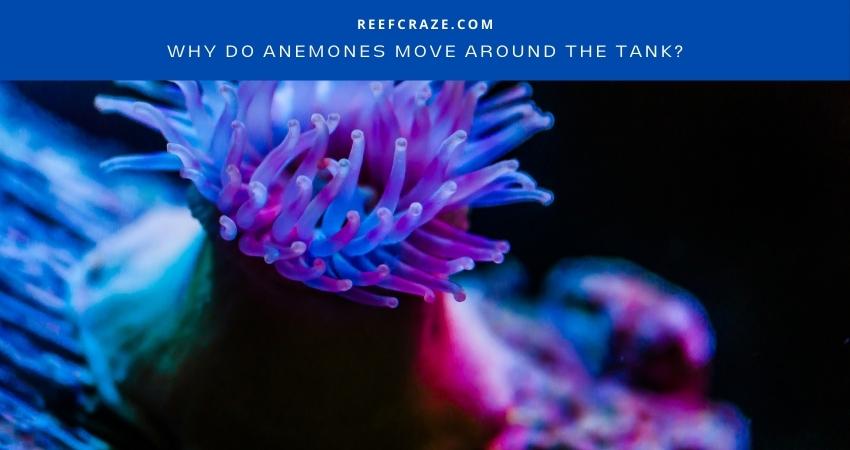Imagine sitting in front of your reef aquarium, enjoying its aesthetical beauty after a long day, only to get creeped out and see your anemones move around the tank abruptly. They are plants, right? They are supposed to sit tight peacefully and not move! Then why do Anemones move?
Anemones can walk. When anemones find a comfortable position, they lock themselves by attaching to rocks. If otherwise, they leave that place and start looking for a more suitable spot.
That means your anemones move around the tank when they are not happy where they are, indicating you should quickly do something about it.
Why Is It Important To Keep The Anemones Happy?
It is vital to keep the anemones happy because they can become aggressive otherwise. You do not want that to happen in your reef tank.
Having disturbed anemones can result in your corals getting stung or staying in an unsafe pump inlet, causing their demise. Simply put, they will create unbalance in the tank environment, being threats to the other reverberates. Hence, you do not want to mess with them.

Why Do Anemones Move Around The Tank?
If an anemone finds a sweet home in one tank spot, why would it need to switch that place? That depends on a number of variables.
For example, anemones require high maintenance and care regarding feeding, temperature, water flow, water quality, and lighting. If anything is wrong with any of those parameters while an anemone stays buried in one place, it will uproot it to find a better place.
How To Take Care Of My Anemones?
You can do the following things to establish your tank as a safe and secure place for your anemones.
Keeping The Tank Water Clean
When it is about anemones, the water quality impacts their well-being and happiness massively.
Do not let your tank water have any debris at all while it maintains lots of oxygen. The pH has to be strictly around 8.2, and the temperature, 77-degree Fahrenheit.
Anemones are not good at adjusting to changes. So the parameters need to remain as steady as possible.
Good Water Flow
Anemones utilize the tide to find their food. That is why they need decent water movements. If your tank fails to give them that, they will constantly move to and fro around the tank.
In addition, a moderate current enables anemones to receive as much oxygen as they need.
All in all, a good water flow is essential to keep your anemones happy. That being said, I advise you to research specific anemones and see what type of water flow they require before adding them to your tank.
Creating The Right Tank Atmosphere
Sea anemones are highly susceptible to the environment around them. Therefore, it is paramount to position them in an appropriate spot with the substrate and rocks they need.
Note with the attention that different anemones demand different things. It would be unwise not to research the kind you want to purchase for your tank.
For instance, bubble tips enjoy surrounding themselves with rocks. It makes them feel secure. Since they often roam around, you can put rocks all over the tank so that they can easily find their comfy spot.
On the contrary, a corkscrew anemone will go along with soft substrates like sand or mud because they lock themselves in the ground.
Always gather knowledge on the requirements of your chosen anemone before purchasing them. Purchase them only when you are sure you can create the right tank atmosphere for it.
Sufficient Lighting
Anemones live better when the tank lighting is sufficient as they get most of the nutrients from photosynthesis. Hobbyists usually arrange a lighting system of 4 watts for each gallon and get good results.
But do not use it as a rule of thumb because it varies from one anemone to another. It is highly crucial to provide your anemones with the perfect lighting.
Otherwise, they will suffer bleaching losing their color due to the absence of zooxanthellae. If you notice anything like that in your anemones, change the lighting ASAP before too late.
Feeding Them
Anemones are carnivores, requiring you to feed them. While they get the nutrients from the water, debris, and lighting in your tank, it is not enough to keep them thriving.
If you let them depend on photosynthesis only, they will starve and shrink soon. The suggestion here is to give your anemones food once every two weeks.
They eat mussels, clams, and scallops. Place a little of them as near as you get to an anemone’s mouth. They should respond immediately to take the food.
Sometimes they may not eat during every feeding, being not hungry enough. Do not worry when that happens.
A Common Mistake Reefers Make
Adding anemones before your tank has perfectly matured is one of the most common and dangerous mistakes reefers make.
A tank may take several weeks for its nitrogen cycle to complete, but it will take longer to mature adequately. It reaches its maturity stage after running for at least a year. Only then can you consider it less vulnerable to water parameter changes and more suitable for its inhabitants.
Again, anemones do not deal well with changes. So you have to bring them only when you are sure the tank has a stable environment.
Final Words
So, when your anemones creep you out by wandering in your tank, do not just sit and wonder, “Why do anemones move around the tank?!?” Get up and see what is wrong.
It may be improper lighting, fluctuating water parameters, or lack of food. Find out what is causing them to move and act on it.
One thing clear is that upset anemones will turn your tank environment turbulent, posing threats to the other animals. As long as your anemones are happy, your other friends will also remain happy. And so will you, right?
